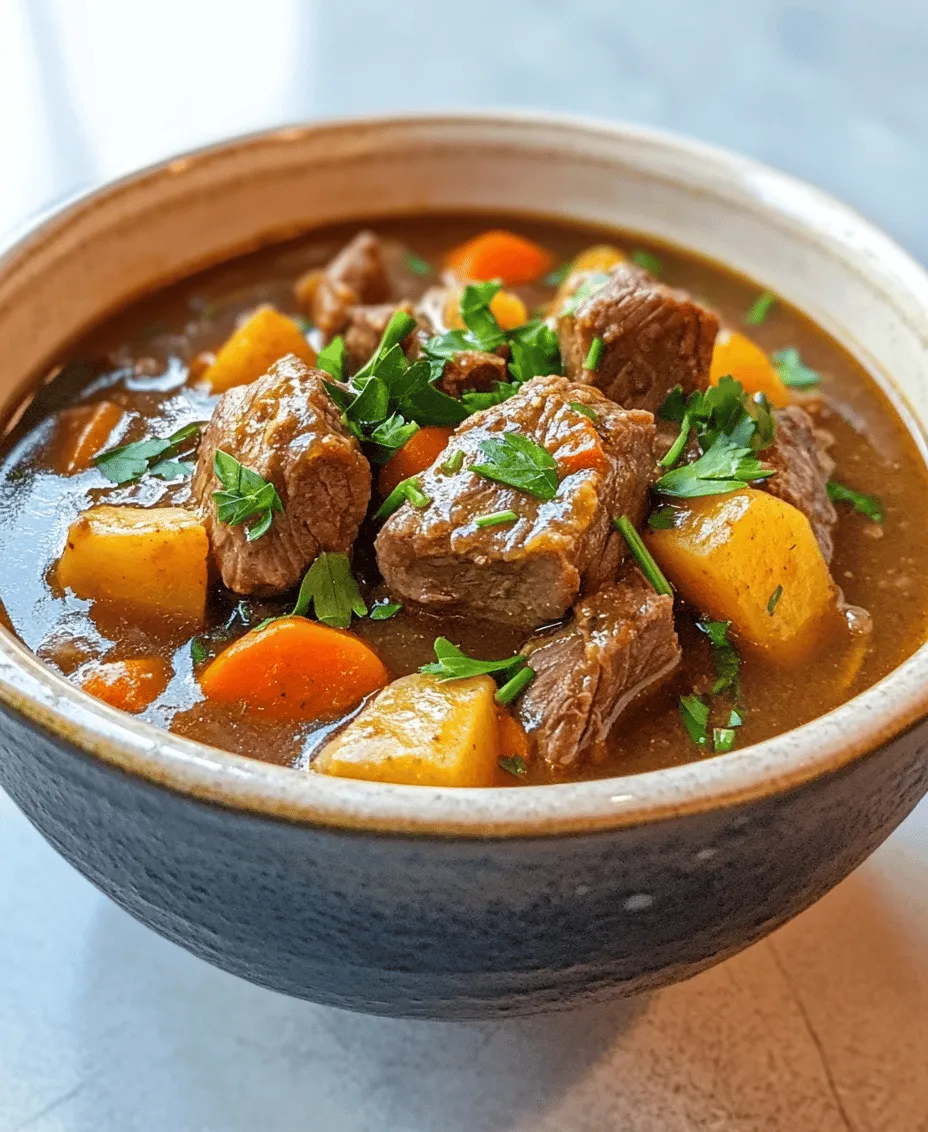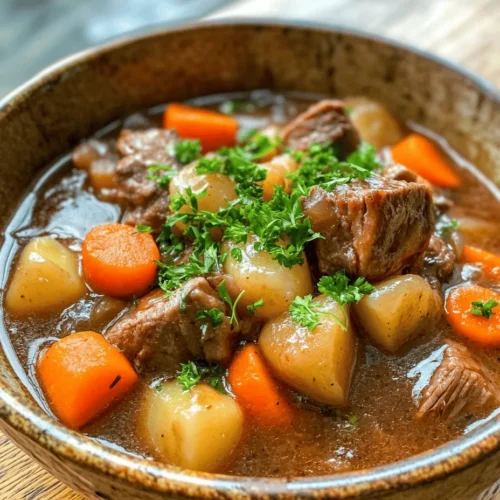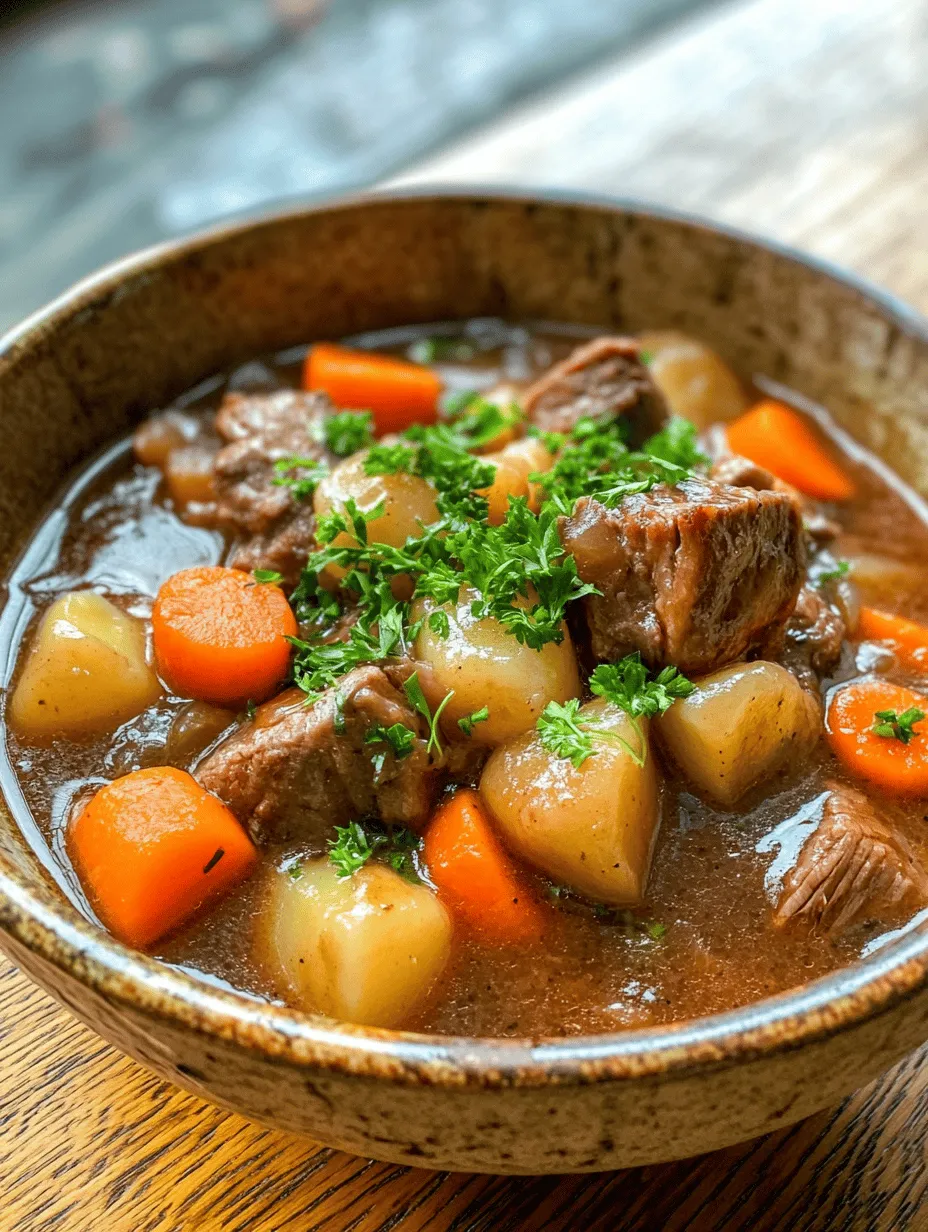Introduction
There’s something undeniably comforting about a well-cooked pot roast. This classic dish has graced dining tables for generations, evoking memories of family gatherings and cozy dinners. Pot roast, with its tender meat and flavorful vegetables, is more than just a meal; it’s a culinary hug that warms the soul. The secret to a perfect pot roast lies not only in the technique but also in the quality of the ingredients used. A rich, flavorful broth, fresh root vegetables, and a well-chosen cut of meat all contribute to the depth of flavor that makes pot roast truly unforgettable.
One of the many appealing aspects of pot roast is its nature as a one-pot meal. After a busy day, the thought of preparing a wholesome dinner without generating a mountain of dishes can be incredibly inviting. With just a few simple steps, you can create a hearty meal that feeds the whole family and fills the kitchen with enticing aromas. The convenience of cooking everything in a single vessel means less time spent cleaning up and more time enjoying the company of loved ones.
Understanding Pot Roast
At its core, pot roast is a method of cooking tougher cuts of meat through a slow braising process. This technique involves searing the meat to develop a rich crust, then cooking it slowly with moisture in a covered pot, where it becomes tender and infused with flavor. The history of pot roast is deeply rooted in American culinary traditions, with its origins often traced back to European immigrants who adapted their cooking styles to available ingredients in the New World.
Pot roast has various regional variations, each reflecting local tastes and available ingredients. In the American South, you might find pot roast flavored with a mix of spices and served alongside biscuits, while in the Midwest, it often pairs with hearty vegetables and creamy mashed potatoes. The cultural significance of pot roast is profound, representing not just sustenance but also connection, community, and home.
From a nutritional standpoint, pot roast offers a balanced meal packed with protein and essential vitamins. The beef chuck roast provides a significant source of protein, which is vital for muscle repair and overall health. Meanwhile, the root vegetables—like carrots and potatoes—bring a wealth of vitamins and minerals to the table, making this dish not only hearty but also nourishing.
Selecting the Right Cut of Meat
When it comes to preparing a perfect pot roast, the choice of beef is paramount. The ideal cut for pot roast is the beef chuck roast, which comes from the shoulder area of the cow. This cut is known for its rich flavor and tenderness, especially when cooked low and slow. The marbling in beef chuck roast—little flecks of fat throughout the meat—ensures that it remains moist and flavorful during the cooking process.
When selecting a beef chuck roast at the butcher or grocery store, there are a few key tips to keep in mind. First, look for a roast that has an even layer of marbling. The fat content is crucial because it breaks down during cooking, enhancing the flavor and tenderness of the meat. A good cut will have a bright red color, indicating freshness, and should feel firm but slightly yielding to the touch.
Additionally, consider the size of the roast based on your needs. A typical chuck roast weighs between 3 to 5 pounds, which is usually enough to serve a family of four to six people, with leftovers for the next day. If you’re unsure, don’t hesitate to ask your butcher for recommendations based on your cooking plans.
Essential Ingredients for a Hearty Pot Roast
Creating a truly hearty pot roast requires a selection of quality ingredients that work harmoniously together. Each component plays a vital role in building flavor and texture, resulting in a dish that is both satisfying and memorable. Here’s a detailed look at the essential ingredients you’ll need:
Beef Chuck Roast
As previously mentioned, the beef chuck roast is the star of this dish. Its rich flavor and tenderness make it the perfect choice for pot roast. When you select your beef, aim for a cut that has a good amount of marbling, as this will ensure that your roast remains juicy during the long cooking process.
Root Vegetables
Root vegetables like carrots, Yukon gold potatoes, and onions are classic accompaniments to pot roast.
– Carrots: Sweet and earthy, carrots add a natural sweetness to the dish. They also hold their shape well during cooking, providing a pleasant texture.
– Yukon Gold Potatoes: These potatoes are known for their creamy texture and buttery flavor. They absorb the flavors of the broth beautifully and complement the beef perfectly.
– Onion: Onions add depth and sweetness to the pot roast. As they cook down, they caramelize and enhance the overall flavor profile of the dish.
Aromatics
To elevate the flavor of your pot roast, don’t forget the aromatics. Fresh garlic, thyme, and rosemary are integral to creating a well-rounded taste.
– Garlic: Adds a robust flavor that complements the beef and vegetables wonderfully.
– Thyme: This herb lends an earthy, slightly minty flavor that works well with the richness of the meat.
– Rosemary: With its strong, pine-like aroma, rosemary adds a fragrant touch that enhances the overall dish.
Liquids
The liquids used in pot roast not only keep the meat moist but also serve as the base for a flavorful sauce.
– Beef Broth: A good quality beef broth adds richness and depth to the dish. Opt for low-sodium broth to control the saltiness of the final meal.
– Red Wine: Wine adds a sophisticated layer of flavor. It helps to tenderize the meat as it cooks, infusing the dish with its complex notes. If you’re avoiding wine, you can substitute it with more beef broth or a splash of balsamic vinegar for acidity.
– Worcestershire Sauce: This sauce provides a savory, umami flavor that rounds out the dish beautifully. It’s a secret ingredient that enhances the depth of flavor in the pot roast.
Substitutes and Taste Balance
While the ingredients listed above are essential for a traditional pot roast, there are always alternatives depending on dietary preferences or availability. For example, if you’re looking for a wine substitute, consider using grape juice or a splash of vinegar mixed with water to mimic the acidity and depth. Furthermore, if beef broth is not available, vegetable broth can work well in a pinch, though it may slightly alter the flavor profile.
Preparation Steps for the Perfect Pot Roast
Now that we’ve covered the key ingredients, it’s time to delve into the preparation steps involved in creating a perfect pot roast. While the process might seem daunting at first, following these clear steps will guide you through to a delicious result.
1. Preheat Your Oven: Start by preheating your oven to 300°F (150°C). A low temperature is essential for slow cooking, allowing the meat to become tender without drying out.
2. Sear the Meat: In a heavy-bottomed pot or Dutch oven, heat a tablespoon of oil over medium-high heat. Once hot, season the chuck roast generously with salt and pepper, then sear it on all sides until browned. This step is crucial as it locks in the juices and creates a flavorful crust.
3. Sauté the Aromatics: After searing the meat, remove it from the pot and set it aside. In the same pot, add diced onions and minced garlic, sautéing until softened and fragrant. This will build a strong flavor base for your pot roast.
4. Deglaze the Pot: Pour in the red wine (or your chosen substitute), scraping up any browned bits from the bottom of the pot. This step adds depth to the flavor and prevents sticking during cooking.
5. Add the Vegetables and Broth: Return the seared chuck roast to the pot, adding in the chopped carrots, Yukon gold potatoes, and fresh herbs. Pour in the beef broth and Worcestershire sauce, ensuring the liquid covers the meat and vegetables about halfway.
6. Cover and Cook: Cover the pot with a lid and transfer it to the preheated oven. Allow the pot roast to cook for about 3 to 4 hours, or until the meat is fork-tender. You can check for doneness by inserting a fork into the meat; it should easily pull apart when ready.
By following these initial steps, you’ll be well on your way to creating a delightful and hearty pot roast. Each element contributes to the overall success of the dish, ensuring a satisfying meal that brings warmth and love to your dining table.

Importance of Searing the Beef
Searing the beef is a crucial step in preparing a hearty pot roast. It involves cooking the meat at high temperatures until it develops a rich, brown crust on the surface. This process is not merely for appearance; it’s a scientific transformation known as the Maillard reaction.
The Maillard Reaction and Its Impact on Flavor
The Maillard reaction occurs when proteins and sugars in the meat react under high heat, creating complex flavors and aromas that elevate the overall taste of the dish. This reaction not only enhances the flavor profile of the beef, making it more savory and delicious, but it also contributes to the development of the dish’s color, providing a beautiful visual appeal.
To achieve the perfect sear, ensure your pot or Dutch oven is preheated well before adding the beef. Searing should be done in batches if you’re working with a large piece of meat, allowing enough space for even cooking and preventing steaming. This step creates a flavorful foundation upon which the rest of the dish is built.
Sautéing Vegetables
Once the beef is seared to perfection, it’s time to sauté the vegetables. This step is essential for layering flavors and ensuring that the vegetables contribute to the overall taste of the pot roast.
Benefits of Layering Flavors Through Sautéing
When you sauté vegetables such as onions, carrots, and celery, you unlock their natural sugars, enhancing their sweetness and flavor. Sautéing allows the vegetables to soften while also developing a slight caramelization that adds depth to your pot roast.
Begin by adding the vegetables to the same pot after removing the beef. The residual fat and fond will cling to the vegetables, enriching their taste. Stir occasionally to ensure even cooking, and cook until the vegetables are tender and fragrant, typically around 5 to 7 minutes.
Deglazing the Pot
After sautéing the vegetables, the next important step is deglazing the pot. This technique involves adding liquid to the pot to loosen any browned bits stuck to the bottom, known as fond.
How This Step Enhances the Dish by Capturing Fond
Deglazing is critical as it captures those flavorful bits, which would otherwise be left behind. Using a liquid such as broth, wine, or even water, pour it into the hot pot while scraping the bottom with a wooden spoon. This process not only incorporates those concentrated flavors back into the dish but also prevents burning, ensuring a balanced and rich sauce for your pot roast.
Combining Ingredients for Optimal Cooking
With your beef seared, vegetables sautéed, and the pot deglazed, it’s time to combine all the ingredients for optimal cooking.
Importance of the Right Liquid-to-Meat Ratio
One of the most crucial aspects of a successful pot roast is the liquid-to-meat ratio. Too much liquid can make the meat boil rather than braise, while too little can lead to dryness. A good rule of thumb is to use enough liquid to cover about one-third to half of the meat. This ensures that the beef is adequately submerged to absorb the flavors while still allowing for proper evaporation and concentration of taste.
Cooking Methods: Stovetop vs. Oven
When it comes to cooking your hearty pot roast, you have the flexibility of choosing between stovetop slow cooking and oven roasting. Each method has its unique advantages and considerations.
Comparison of Stovetop Slow Cooking and Oven Roasting
– Stovetop Slow Cooking: This method allows for greater control over the temperature and can be adjusted easily. The heat is evenly distributed, which helps in tenderizing the meat. However, it requires more attention, as you need to monitor the pot to prevent it from boiling over or scorching.
– Oven Roasting: Roasting in the oven provides a more hands-off cooking experience, allowing you to set the temperature and let the roast cook gradually. The dry heat in the oven also creates a different texture, potentially resulting in a crispier exterior. However, it may take longer to reach the desired tenderness compared to stovetop cooking.
Tips on Adjusting Cooking Times Based on Method Used
Regardless of the method chosen, cooking times will vary based on the size of the roast and your specific equipment. As a general guideline, expect to cook the pot roast for about 3 to 4 hours on the stovetop at a low simmer, or approximately 4 to 5 hours in a 325°F oven. Always check for doneness by using a meat thermometer; the internal temperature should reach about 195°F to 205°F for optimal tenderness.
Explanation of How Cooking Methods Affect Texture and Flavor
The stovetop method tends to produce a more moist and tender result due to the direct contact with the heat source and the ability to add liquid as needed. In contrast, oven roasting creates a more concentrated flavor, as the dry heat allows for some evaporation, concentrating the juices and enhancing the overall taste of the pot roast.
Serving Suggestions and Pairings
Once your hearty pot roast is cooked to perfection, it’s time to think about serving suggestions and pairings that will complement this comforting meal.
Ideal Side Dishes to Serve with Pot Roast
Classic sides that pair beautifully with pot roast include:
– Mashed Potatoes: Creamy, buttery mashed potatoes are an exceptional choice, providing a perfect canvas to soak up the flavorful gravy.
– Roasted Root Vegetables: Enhance the dish with seasonal roasted carrots, parsnips, or brussels sprouts that echo the flavors in the pot roast.
– Green Beans or Brussels Sprouts: Lightly steamed or sautéed green veggies add a fresh contrast to the richness of the pot roast.
– Crusty Bread: A loaf of hearty bread or rolls allows diners to mop up the delicious gravy.
Recommendations for Wines or Beverages That Complement the Meal
When it comes to beverages, consider serving a full-bodied red wine such as Cabernet Sauvignon or a Merlot, both of which pair wonderfully with the robust flavors of the pot roast. For a non-alcoholic option, a rich, savory herbal tea can also be a delightful accompaniment.
Creative Ways to Use Leftovers
If you find yourself with leftover pot roast, there are several creative ways to repurpose it.
– Pot Roast Sandwiches: Slice the leftover meat and layer it on a crusty roll with your favorite condiments for a satisfying sandwich.
– Pot Roast Soup: Dice the beef and vegetables, add them to a rich broth with some noodles or rice for a comforting soup.
– Shepherd’s Pie: Use the leftover meat and vegetables as a filling for a hearty shepherd’s pie topped with creamy mashed potatoes.
Conclusion
Making a hearty pot roast is not just about the meal; it’s about the entire experience. From the initial searing of the beef that sets the stage for rich flavors to the careful selection of ingredients and cooking methods, each step contributes to a satisfying finale.
Enjoying pot roast is a comforting tradition that evokes feelings of home and togetherness. The tenderness of the meat, the sweetness of the vegetables, and the depth of the gravy come together to create a dish that warms the soul.
Feel free to explore variations based on personal tastes and seasonal ingredients, whether it’s adding a splash of red wine, experimenting with different root vegetables, or adjusting the herbs to suit your palate. The versatility of pot roast means that you can make it your own, ensuring that every bite is filled with joy and satisfaction. Embrace the process of cooking and the love that goes into preparing a meal that brings family and friends together.


